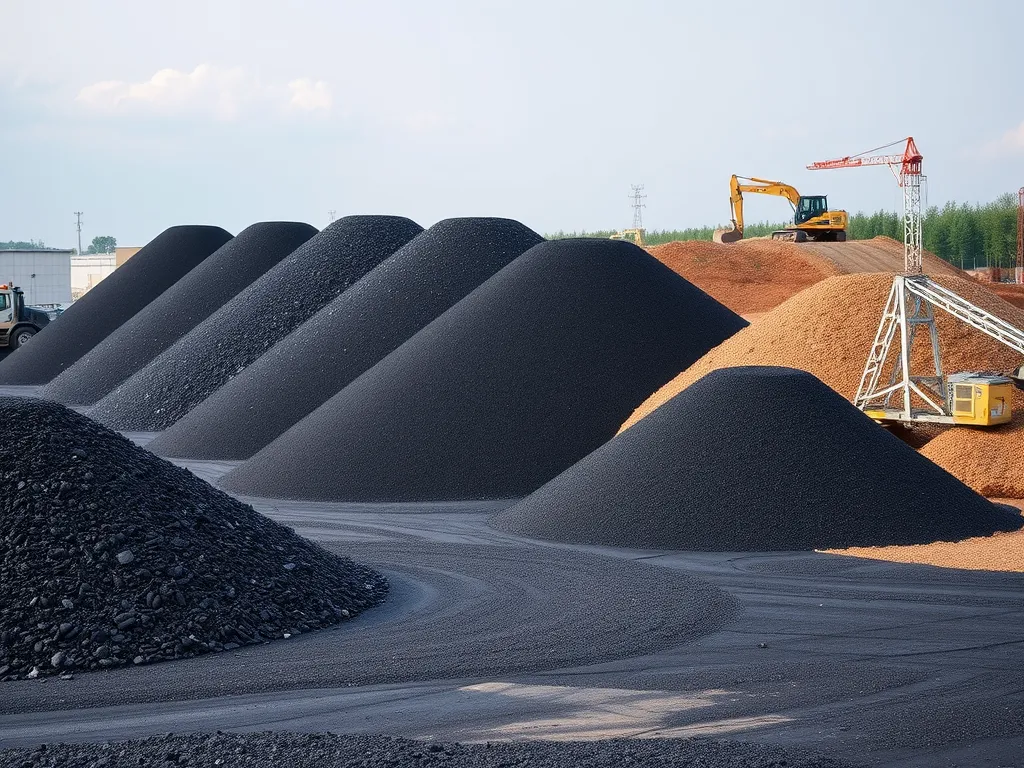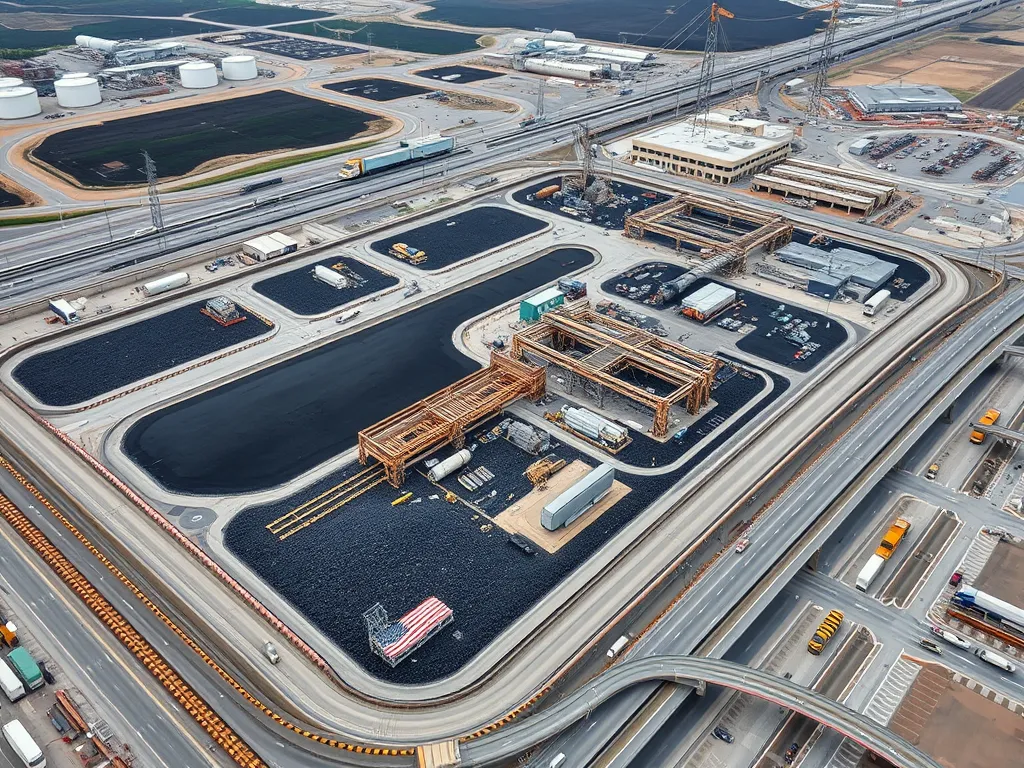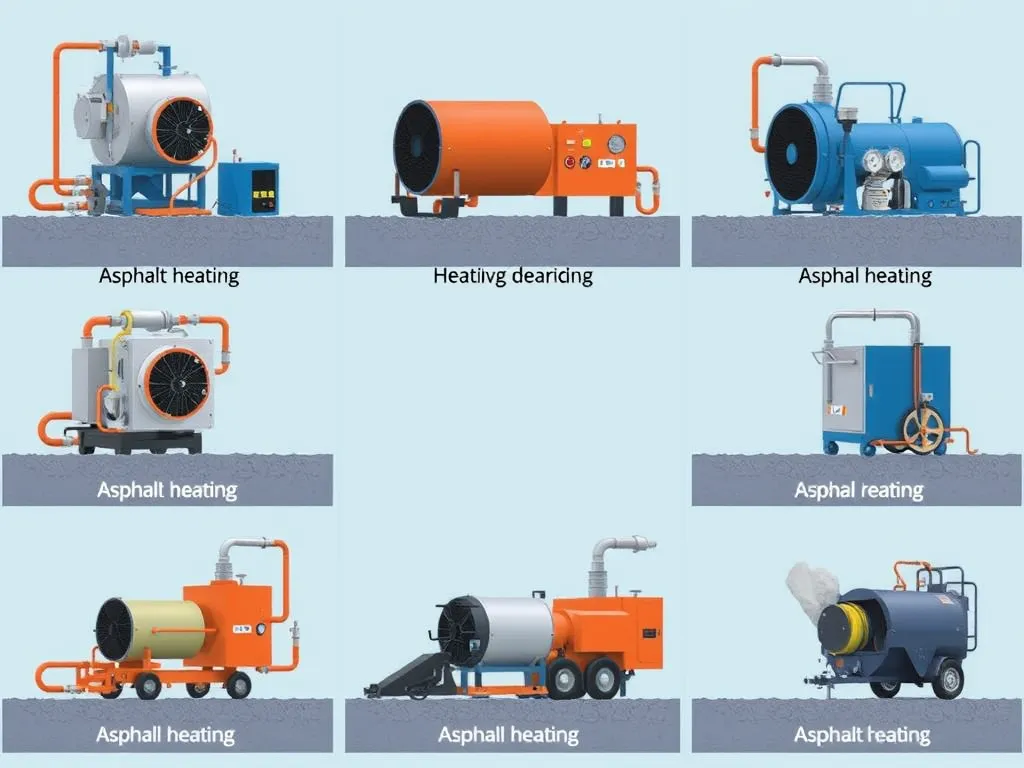Asphalt Supply Chain and Its Economic Effects: Moving America’s Roads From Oil to Pavement
Published on: August 6, 2025 | Last Updated: April 14, 2025
Written By: George Voss
The asphalt supply chain is the network that transforms crude oil into pavement-ready material, directly impacting jobs, construction costs, and infrastructure quality. This system connects refineries producing liquid asphalt (bitumen) with aggregate suppliers, mixing plants, contractors, and transportation firms. Every mile of road built relies on this chain’s efficiency, with delays or price shifts affecting project budgets by up to 15%. Economic ripple effects touch 300,000+ U.S. workers and $30 billion in annual industry revenue.
This article breaks down how asphalt moves from raw materials to your local highway. We’ll explore why crude oil prices sway production costs, how trucking shortages delay projects, and why 95% of old asphalt gets reused. Key topics include refinery operations, logistics bottlenecks, recycling economics, and regulations adding $2-$5 per ton to asphalt prices. Data-driven insights show how supply chain decisions shape road durability, state budgets, and your commute.
Contents
Understanding the Asphalt Supply Chain
The asphalt supply chain moves rocks, sand, and oil from mines and wells to roads. It links raw stuff to final pave jobs through three steps: make, move, lay.
Key Parts Of Asphalt Making and Moving
Asphalt needs three main parts:
- Raw stuff: Rocks (95% of mix), sand, and bitumen (5% sticky binder from oil)
- Mix plants: Heat raw stuff to 300°F, blend into blacktop
- Haul teams: Trucks, rail, or barges move hot mix to sites fast
Time is key. Hot mix cools in 2 hours. Late trucks mean wasted loads.
Who Does What in the Supply Chain
Four groups keep the chain moving:
Makers and Oil Plants
Oil giants like Exxon turn crude into bitumen. Their plants make 400,000 tons each year. Oil price swings hit bitumen costs hard—a $10/barrel rise can spike asphalt prices by $15/ton.
Pavers and Truck Crews
Paving teams lay mix before it cools. Truck firms plan routes—delays cost $50/hour per truck. Smart routing cuts fuel use by 12%, saving $1.2M yearly for big firms.
This web of makers, movers, and layers sets the stage for market shifts. Next, we’ll see how cash flow bends with each link.
Economic Drivers Of the Asphalt Industry
Road work, new builds, and repairs shape asphalt demand. The U.S. uses over 400 million tons of asphalt each year. Supply shifts with crude oil flow, plant sites, and how fast crews can pave. Hot months see more jobs, pushing prices up when stock runs low.
Asphalt Supply and Demand Dynamics
States plan big projects in spring, causing asphalt needs to spike. Short supply in these peaks can hike costs by 8-12%. Plants near cities ease this strain. But remote sites face delays, adding 10-15% to bids for hauling fees.
Factors Influencing Asphalt Price Fluctuations
Asphalt costs swing with three key inputs: crude oil rates, trucking fees, and crew wages. A $10 shift in oil per barrel can alter asphalt prices by $15-$20 per ton. Labor gaps or fuel hikes add 5-7% to project spends.
Crude Oil Price Volatility
Bitumen, asphalt’s glue, comes from oil refining. Oil makes up 60-70% of asphalt costs. When crude jumps to $100/barrel, asphalt may surge $25/ton. Refiners pass these hikes to plants, then to road jobs.
Transportation and Labor Costs
Moving hot asphalt needs special trucks and tight timelines. Hauling fees eat 15-30% of total costs. Driver shortages or diesel spikes strain budgets. Crew wages, up 4.5% yearly, push paving bids higher for towns and firms.
These price forces shape how towns plan roads and fix potholes. Next, we break down where each dollar goes in making and moving asphalt.

Cost Structure Of the Asphalt Supply Chain
Asphalt costs hinge on two key phases: making the mix and moving it. Each step adds layers to the final price tag.
Breakdown Of Asphalt Production Costs
Making asphalt eats up 70-80% of total costs. Key factors:
- Bitumen (60-70%): This black glue from crude oil shifts with global oil prices. A $10/barrel rise can spike costs by $15/ton.
- Aggregates (20-30%): Rocks and sand vary by region. Sourcing within 50 miles cuts fees by 12%.
- Energy ($8-$12/ton): Heating mixers to 300°F needs fuel. Plants using recycled asphalt cut energy use by 20%.
- Labor ($4-$6/ton): Skilled crews run plants and gear. Wage hikes add $1.50/ton yearly.
Impact Of Supply Chain Logistics on Final Pricing
Moving asphalt adds 15-30% to costs. Trucks haul 80% of loads but cost $2.50/mile. Rail cuts rates by 40% for long hauls but needs extra handling. Delays from bad roads or weather can lift prices by $8/ton. Storing hot asphalt in tanks costs $1.50/ton monthly. Plants beyond 100 miles from job sites face 18% higher fees.
These cost layers shape bids for roads, roofs, and lots. Yet hurdles in moving and storing asphalt ripple through budgets. Up next: how supply chain gaps hit projects.
Also See: Cold Mix Asphalt Formulation Variations for Cost Savings
Challenges in Asphalt Supply Chain Management
Moving asphalt from origin to paving sites brings logistical hurdles. Each link in this chain impacts costs, timelines, and infrastructure outcomes.
Transportation and Storage Constraints
Hot-mix asphalt must stay above 275°F during transit to avoid hardening. Trucks with insulated tanks haul it within a 300-mile radius—beyond that, material cools, risking waste. Storage silos at plants add $50,000-$200,000 annually in upkeep. During roadwork peaks, shortages of haul trucks can delay projects by weeks, inflating labor costs by up to 15%.
Regulatory Compliance and Tariff Pressures
Strict air quality rules, like EPA’s 2020 limits on volatile organics, push plants to install $1.2M+ scrubber systems. Tariffs on Canadian bitumen—a key U.S. supply source—spiked import costs by 18% in 2023. Cross-state transport permits vary: California’s axle weight laws cut truck loads by 5 tons, requiring 20% more trips. Non-compliance fines hit $37,500 per violation, squeezing margins.
Limited Recycled Asphalt Availability
Only 21% of U.S. roads use recycled asphalt pavement (RAP) due to milling limits and quality concerns. RAP saves $25/ton vs. virgin mix but faces supply gaps. Aging pavements yield less usable material, and stockpiling RAP requires costly anti-clumping additives. Plants with 15% RAP capacity lose $4M yearly if sourcing falters. Rising demand for sustainable roads outpaces recycling infrastructure growth.
Navigating these barriers shapes how asphalt supply chain logistics influence roadbuilding budgets. Next, balancing fiscal goals with sustainability targets adds another layer of complexity.

Environmental Considerations in Asphalt Economics
Balancing ecological responsibility with economic viability shapes modern asphalt production. Industry practices now prioritize minimizing environmental harm while managing operational costs.
Recycled Asphalt and Sustainability Practices
Reclaimed Asphalt Pavement (RAP) reuse reached 95 million tons in 2022. This material gets crushed and blended with fresh bitumen, cutting raw aggregate demand by 40%. Recycling slashes supply chain costs through reduced mining, transportation, and disposal needs.
Plants using 25% RAP mixtures save $8-$12 per ton on materials. Warm-mix asphalt technology boosts these gains, lowering production temps by 50°F (28°C) and cutting fuel use by 20%. States like California now mandate 35% recycled content for highway projects, reshaping regional asphalt supply chain logistics.
| Practice | Cost Impact | Emission Reduction |
|---|---|---|
| 25% RAP Usage | -$10/ton | 18% CO2 |
| Warm-Mix Adoption | +$3/ton upfront | 25% NOx |
| Solar-Heated Storage | -$1.50/ton annual | 12% Energy |
Cost Implications Of Environmental Regulations
EPA guidelines now require asphalt plants to install $500,000+ emission control systems. Carbon taxes add $7-$30 per ton of mix in regulated states, directly affecting asphalt price fluctuations. These rules create regional cost disparities – a Texas plant spends 22% less on compliance than a New York counterpart.
Permitting delays for new facilities stretch to 18 months in eco-sensitive zones, inflating project budgets by 15%. Yet green incentives exist: federal grants cover 40% of solar-drying system costs, while carbon credit trading nets plants $2-$5 per ton on low-emission batches.
Up next: How workforce trends and tech innovations are reshaping asphalt supply chain management.
Frequently Asked Questions
Is Asphalt a Byproduct Of Crude Oil?
Yes, asphalt is derived from the distillation process of crude oil. During this process, heavier fractions are separated, which includes the production of bitumen, the main component of asphalt.
How Do Supply Chain Issues Affect Asphalt Prices?
Supply chain issues can lead to delays or increased costs in transportation and production, which directly impacts asphalt prices. For instance, a shortage of trucking resources can inflate hauling costs, and any disruption in the supply chain can cause a ripple effect, driving up final project expenses.
Is Asphalt in High Demand Globally?
Yes, asphalt is in high demand globally, largely driven by infrastructure development, road building, and maintenance projects. As countries invest in transportation networks, the demand for asphalt continues to rise.
What Determines the Number Of Asphalt Plants?
The number of asphalt plants is determined by several factors, including regional demand for paving material, the proximity to crude oil sources, transportation logistics, and regulatory requirements. Local government initiatives and infrastructure projects also play a significant role in influencing the location and number of asphalt plants.

Closing Thoughts
The asphalt supply chain significantly influences the economy, impacting everything from production costs to market pricing. Understanding its dynamics helps stakeholders make informed decisions in construction and infrastructure development.
Key economic interdependencies shape the asphalt industry. Fluctuations in crude oil prices and rising transportation costs can directly affect asphalt prices, while challenges like regulatory compliance and limited recycled materials present ongoing hurdles. Embracing sustainable practices can mitigate some of these impacts, but it requires collaboration across the supply chain.
In summary, the asphalt industry’s economic effects extend beyond pricing and production. They affect labor markets, infrastructure investment, and overall economic growth. By addressing challenges and leveraging opportunities in the supply chain, industry participants can support sustainable development and enhance infrastructure resilience.
For more information on asphalt and its economic implications, check out Asphalt Calculator USA.
Additional Resources for You:
- Kett, I. (1999). Asphalt Materials and Mix Design Manual. Oxford: Elsevier Science.
- Strategies for Improving the Sustainability of Asphalt Pavements
- Asphalt Manufacturing in the US – Market Research Report (2015-2030)
- Industry Focus: Creating Value in Asphalt Paving – Ironline Advisors
- What Lies Ahead For Asphalt Maintenance and Paving Industry?


